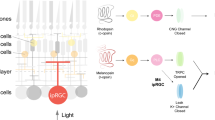Summary
The rhinophores (posterior tentacles) of the head ofAplysia (Fig. 1) are well known as chemical and tactile sensors. Here, they are shown to be excellent photoreceptors too.
-
1.
Illumination of the rhinophore of an isolated preparation of the rhinophores-cerebral ganglion-eye (Fig. 2) evoked neuronal activity in cerebral neurons and efferent activity in the optic nerve (Fig. 3).
-
2.
Evoked activity in the ipsilateral optic nerve was a phasic burst of unitary spikes at “on”. The number of spikes was approximately proportional to the log of intensity (Fig. 4). After the phasic “on” response the normally ongoing efferent activity originating in the cerebral ganglion and recorded in the optic nerve was suppressed briefly but resumed if the light was continued for minutes (Fig. 3).
-
3.
The spectral sensitivity of the rhinophore and eye are similar. Both have a peak near 500 nm and sensitivity is 1 log unit less at 405 nm and 1.7 log units less at 660 nm than at 500 nm (Fig. 6).
-
4.
The greatest photosensitivity of the rhinophore is at the tip in the sensory groove (Fig. 2) directed laterally and upward from the head.
-
5.
The rhinophores may serve as extraocular photoreceptors to the circadian systems or modulators of ocular photosensitivity and they may also function in simple visual discriminations since orienting movements of the rhinophores were evoked by illumination of the head of intactAplysia.
Similar content being viewed by others
Abbreviations
- CAP :
-
compound action potential
- ASW :
-
artifical sea water
References
Arvanitaki, A., Chalazonitis, N.: Réactions bioélectroniques neuroniques à la photoactivation specifique d'une heme-proteine et d'une carotène-proteine. Arch. Sci. Physiol.3, 07–44 (1949)
Audesirk, T.E.: Chemoreception inAplysia californica I. Behavioral localization of distance chemoreceptors used in food-finding. Behav. Biol.15, 45–55 (1975)
Barlow, R., Bolanowski, S., Brachman, M.: Efferent optic nerve fibers mediate circadian rhythms in theLimulus eye. Science197, 86–89 (1977)
Block, G.: Efferent control of the circadian oscillator in the eye ofAplysia. Ph. D. thesis, University of Oregon (1975)
Block, G.D., Hudson, I.J., Lickey, M.E.: Extraocular photoreceptors can entrain the circadian oscillator in the eye ofAplysia. J. Comp. Physiol.89, 237–249 (1974)
Block, G.D., Smith, J.T.: Cerebral photoreceptors inAplysia. Comp. Biochem. Physiol.46A, 115–121 (1973)
Brown, A.M., Brown, H.M.: Light response of a giantAplysia neuron. J. Gen. Physiol.62, 239–254 (1973)
Chase, R.: Photic sensitivity of the rhinophore inAplysia. Can. J. Zool.57, 698–701 (1979)
Dijkgraaf, S.: Über Hautlichtempfindlichkeit beiAplysia limacina. Zool. Anz.111, 254–256 (1935)
Emery, D.G., Audesirk, T.E.: Sensory cells inAplysia. J. Neurobiol.9, 173–179 (1978)
Eskin, A.: Properties of theAplysia visual system: in vitro entrainment of the circadian rhythm and centrifugal regulation of the eye. Z. Vergl. Physiol.74, 353–371 (1971)
Gillary, H.: Light-evoked electrical potentials from the eye and optic nerve ofStrombus: response waveform and spectral sensitivity. J. Exp. Biol.60, 383–396 (1974)
Hanström, B.: Vergleichende Anatomie des Nervensystems der Wirbellosen Tiere, pp. 193–194. Berlin: Springer 1928
Hughes, H.: A light and electron microscope study of some opisthobranch eyes. Z. Zellforsch.106, 79–98 (1970)
Jacklet, J.W.: Electrophysiological organization of the eye ofAplysia. J. Gen. Physiol.53, 21–42 (1969a)
Jacklet, J.W.: Circadian rhythm of optic nerve impulses recorded in darkness from isolated eye ofAplysia. Science164, 562–564 (1969b)
Jacklet, J.W., Alvarez, R., Bernstein, B.: Ultrastructure of the eye ofAplysia. J. Ultrastruct. Res.38, 246–261 (1972)
Jahan-Parwar, B.: Behavioral and electrophysiological studies on chemoreception inAplysia. Am. Zool.12, 525–537 (1972)
Lickey, M.E., Wozniak, J.A.: Circadian organization inAplysia explored with red light, eye removal and behavioral recording. J. Comp. Physiol.131, 169–177 (1979)
Lickey, M.E., Wozniak, J.A., Block, G.D., Hudson, D.J., Augter, G.K.: The consequences of eye removal for the circadian rhythm of behavioral activity inAplysia. J. Comp. Physiol.118, 121–143 (1977)
Luborsky-Moore, J.L., Jacklet, J.W.:Aplysia eye: modulation by efferent optic nerve activity. Brain Res.115, 501–505 (1976)
Lukowiak, K., Jacklet, J.W.: Habituation and dishabituation mediated by the peripheral and central neural circuits of the siphon ofAplysia. J. Neurobiol.6, 183–200 (1975)
Menzel, R.: Spectral sensitivity and color vision in invertebrates. In: Handbook of sensory physiology, Vol. VII/6A. Autrum, H. (ed.), pp. 503–580. Berlin, Heidelberg, New York: Springer 1979
Waser, P.M.: The spectral sensitivity of the eye ofAplysia californica. Comp. Biochem. Physiol.27, 339–347 (1968)
Author information
Authors and Affiliations
Additional information
I thank Thea Hoteling for technical assistance. Supported by NSF grant BN 11154.
Rights and permissions
About this article
Cite this article
Jacklet, J.W. Light sensitivity of the rhinophores and eyes ofAplysia . J. Comp. Physiol. 136, 257–262 (1980). https://doi.org/10.1007/BF00657541
Accepted:
Issue Date:
DOI: https://doi.org/10.1007/BF00657541




